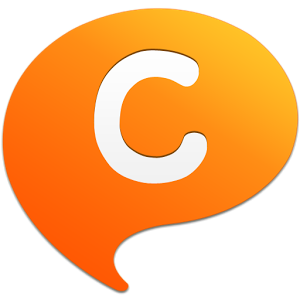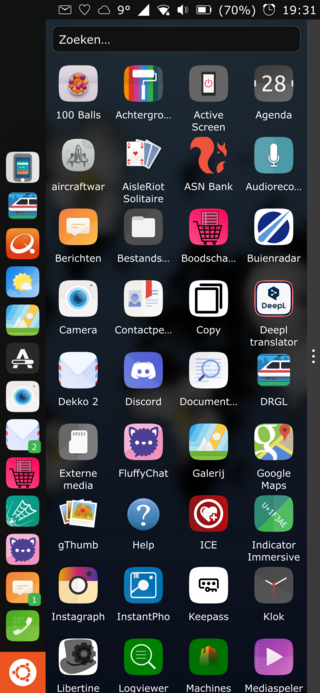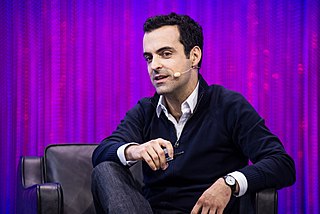Related Research Articles

A tablet computer, commonly shortened to tablet, is a mobile device, typically with a mobile operating system and touchscreen display processing circuitry, and a rechargeable battery in a single, thin and flat package. Tablets, being computers, do what other personal computers do, but lack some input/output (I/O) abilities that others have. Modern tablets largely resemble modern smartphones, the only differences being that tablets are relatively larger than smartphones, with screens 7 inches (18 cm) or larger, measured diagonally, and may not support access to a cellular network. Unlike laptops, tablets usually run mobile operating systems, alongside smartphones.

Android is a mobile operating system based on a modified version of the Linux kernel and other open-source software, designed primarily for touchscreen mobile devices such as smartphones and tablets. Android is developed by a consortium of developers known as the Open Handset Alliance, though its most widely used version is primarily developed by Google. It was unveiled in November 2007, with the first commercial Android device, the HTC Dream, being launched in September 2008.

Sygic is a Slovak company of global automotive navigation systems for mobile phones and tablets. The company was founded in 2004 and is headquartered in Bratislava, Slovakia. It became the first company to offer navigation for iPhone and second for Android. In 2015 Sygic reached milestone of 100 million downloads of its navigation app.

Bump! is a discontinued iOS and Android mobile app that enables smartphone users to transfer contact information, photos and files between devices. In 2011, it was #8 on Apple's list of all-time most popular free iPhone apps, and by February 2013 it had been downloaded 125 million times. Its developer, Bump Technologies, shut down the service and discontinued the app on January 31, 2014, after being acquired by Google for Google Photos and Android Camera.
The history of tablet computers and the associated special operating software is an example of pen computing technology, and thus the development of tablets has deep historical roots. The first patent for a system that recognized handwritten characters by analyzing the handwriting motion was granted in 1914. The first publicly demonstrated system using a tablet and handwriting recognition instead of a keyboard for working with a modern digital computer dates to 1956.
ConnectWise ScreenConnect, previously ConnectWise Control, is a self-hosted remote desktop software application. It was originally developed by Elsinore Technologies in 2008 under the name ScreenConnect, and is now owned by ConnectWise Inc.

Firefox OS is a discontinued open-source operating system – made for smartphones, tablet computers, smart TVs, and dongles designed by Mozilla and external contributors. It is based on the rendering engine of the Firefox web browser, Gecko, and on the Linux kernel. It was first commercially released in 2014.
A mobile application or app is a computer program or software application designed to run on a mobile device such as a phone, tablet, or watch. Mobile applications often stand in contrast to desktop applications which are designed to run on desktop computers, and web applications which run in mobile web browsers rather than directly on the mobile device.
Carrier IQ was a privately owned mobile software company founded in 2005 in Sunnyvale, California. It provided diagnostic analysis of smartphones to the wireless industry via the installation of software on the user's phone, typically in a manner that cannot be removed without rooting the phone. The company says that its software is deployed in over 150 million devices worldwide.
Whisper Systems was an American enterprise mobile security company that was co-founded by security researcher Moxie Marlinspike and roboticist Stuart Anderson in 2010. The company was acquired by Twitter in November 2011. Some of the company's software products were released under open-source licenses after the acquisition. An independent group called Open Whisper Systems later picked up the development of this open-source software, which led to the creation of the Signal Technology Foundation.
Skyfire is a software company founded in 2007, and acquired by Opera Software ASA, now Otello Corporation, in 2013. In 2015, the company became the Network Solutions division of Opera, and ceased using the Skyfire brand name. They offer network optimization technologies including video optimization and monetization tools for carriers. Skyfire discontinued its Skyfire Web Browser in 2014 in order to consolidate its focus on its mobile operator technology. Skyfire was funded by venture capital, and was acquired by Opera Software ASA in March 2013.

ChatON was a global mobile communication service introduced by Samsung Electronics in September 2011. ChatON served more than 120 countries in 62 languages. ChatON was available on Android, iOS, BlackBerry, Windows Phone, Windows Mobile (Korea), and Bada smartphones. Additionally, a web client was offered for access to the service via web browsers. Users could invite and register buddies via Facebook and Twitter as well as share ChatON content on Facebook. Among ChatON's unique features were allowing users to create Animation messages, Broadcast to send personal notices in a group chat room, and the Trunk which stores media files shared in chats. When a user logs in ChatON, the user's buddy list is available on any connected device.

Ubuntu Touch is a mobile version of the Ubuntu operating system, being developed by the UBports community. Its user interface is written in Qt, and is designed primarily for touchscreen mobile devices such as smartphones and tablet computers, but the original goal of convergence was intended to bring Ubuntu Touch to laptops, desktops, IOT devices and TVs for a complete unified user experience.
A lock screen is a computer user interface element used by various operating systems. They regulate immediate access to a device by requiring the user to perform a certain action in order to receive access, such as entering a password, using a certain button combination, or performing a certain gesture using a device's touchscreen. There are various authentication methods to get past the lock screen, with the most popular and common ones being personal identification numbers (PINs), the Android pattern lock, and biometrics.

Facebook Home was a user interface layer for Android smartphones. Developed by the company then known as Facebook, the software was designed to be a drop-in replacement for the device's existing home screen ("launcher"). It provided a replacement home screen that allowed users to easily view and post content on Facebook along with launching apps, a replacement lock screen that displayed notifications from Facebook and other apps, and an overlay which allowed users to chat via Facebook messages or SMS from any app. Facebook Home was unveiled at a press event on April 4, 2013, and was released on April 12, 2013 for a limited selection of devices from HTC and Samsung Electronics—including the HTC First, a new smartphone pre-loaded with the software. Facebook is no longer supporting or providing updates for Facebook Home.

Tango was an augmented reality computing platform, developed and authored by the Advanced Technology and Projects (ATAP), a skunkworks division of Google. It used computer vision to enable mobile devices, such as smartphones and tablets, to detect their position relative to the world around them without using GPS or other external signals. This allowed application developers to create user experiences that include indoor navigation, 3D mapping, physical space measurement, environmental recognition, augmented reality, and windows into a virtual world.

SensoMotoric Instruments (SMI) was a German provider of dedicated computer vision applications with a major focus on eye tracking technology. SMI was founded in 1991 as a spin-off from academic and medical research at the Free University of Berlin. The company has its headquarters in Teltow near Berlin, Germany, offices in Boston, Massachusetts and San Francisco, California, in the United States, and a worldwide distributor and partner network.

Hugo Barra is a Brazilian computer scientist, technology executive and entrepreneur. From 2008 to 2013, he served in a number of product management roles at Google in London and California, including Vice President and product spokesperson of Google's Android division. From 2013 to 2017, he worked at Xiaomi as vice president, Global. From 2017 to 2021, he worked as Vice President of Virtual Reality and Head of the Oculus division at Facebook. In May 2021, he left Facebook to start health technology startup Detect.

Kubity is a cloud-based 3D communication tool that works on desktop computers, the web, smartphones, tablets, augmented reality gear, and virtual reality glasses. Kubity is powered by several proprietary 3D processing engines including "Paragone" and "Etna" that prepare the 3D file for transfer over mobile devices.
A virtual reality headset is a head-mounted device that provides virtual reality for the wearer. VR headsets are widely used with VR video games but they are also used in other applications, including simulators and trainers. VR headsets typically include a stereoscopic display, stereo sound, and sensors like accelerometers and gyroscopes for tracking the pose of the user's head to match the orientation of the virtual camera with the user's eye positions in the real world.
References
- ↑ "The Eye Tribe. "The Eye Tribe." The Eye Tribe. N.p., 2013. Web. 12 Oct. 2013".
- 1 2 "Topalian, Claire. "SW Team The Eye Tribe Leads a $4.4 Million Government-Funded Project! » UP Global." UP Global. N.p., 24' Dec. 2012. Web. 22 Oct. 2013".
- ↑ "OUR BIG MISSION." The Eye Tribe. The Eye Tribe, 2013. Web. 21 Oct. 2013. <https://theeyetribe.com/about/>.
- ↑ Parsons, Tom. "The Eye Tribe (formerly Senseye) Appointed "Cool Vendor 2012" & Needs Your Input!" Welcome to Startupbootcamp. N.p., 22 June 2012. Web. 21 Oct. 2013. <http://www.startupbootcamp.org/blog/the-eye-tribe-formerly-senseye-appointed-cool-vendor-2012-needs-your-input.html>.
- ↑ ""Products - The Eye Tribe" Products - The Eye Tribe. The Eye Tribe, 2015. Web. 15 Jul. 2015".
- ↑ "Senseye – A Technology to Control Your Tablet Using Your Eye." New Tech World. N.p., 28 Oct. 2012. Web. 1 Nov. 2013. <http://newtechworld.net/senseye-a-technology-to-control-your-tablet-using-your-eye/>.
- ↑ NPR. "Assistive Technology Blog: The Eye Tribe: Eye Tracker in Tablets." Assistive Technology Blog. N.p., 3 Dec. 2012. Web. 1 Nov. 2013. <http://www.assistivetechnologyblog.com/2012/12/the-eye-tribe-eye-tracker-in-tablets.html>.
- ↑ Etherington, Darrell. "The Eye Tribe Starts Pre-Orders For $99 Eye Tracking Developer Device For Windows PCs." TechCrunch. N.p., 5 Sept. 2013. Web. 1 Nov. 2013. <https://techcrunch.com/2013/09/05/the-eye-tribe-starts-pre-orders-for-99-eye-tracking-developer-device-for-windows-pcs/>.
- ↑ ""THE EYE TRIBE TRACKER." The Eye Tribe. N.p., 2013. Web. 1 Nov. 2013".
- ↑ "PRESS." The Eye Tribe. N.p., 17 Apr. 2013. Web. 12 Nov. 2013. <https://theeyetribe.com/press/>.
- 1 2 Rice, Jeremiah. "Android Police – Android News, Apps, Games, Phones, Tablets." Android Police. N.p., 5 Sept. 2013. Web. 1 Nov. 2013. <http://www.androidpolice.com/2013/09/05/the-eye-tribe-demonstrates-an-impressive-eye-tracking-suite-on-android-via-a-usb-dongle/>.
- ↑ Constine, Josh (28 December 2016). "Oculus acquires eye-tracking startup The Eye Tribe". TechCrunch. Retrieved 2017-01-09.